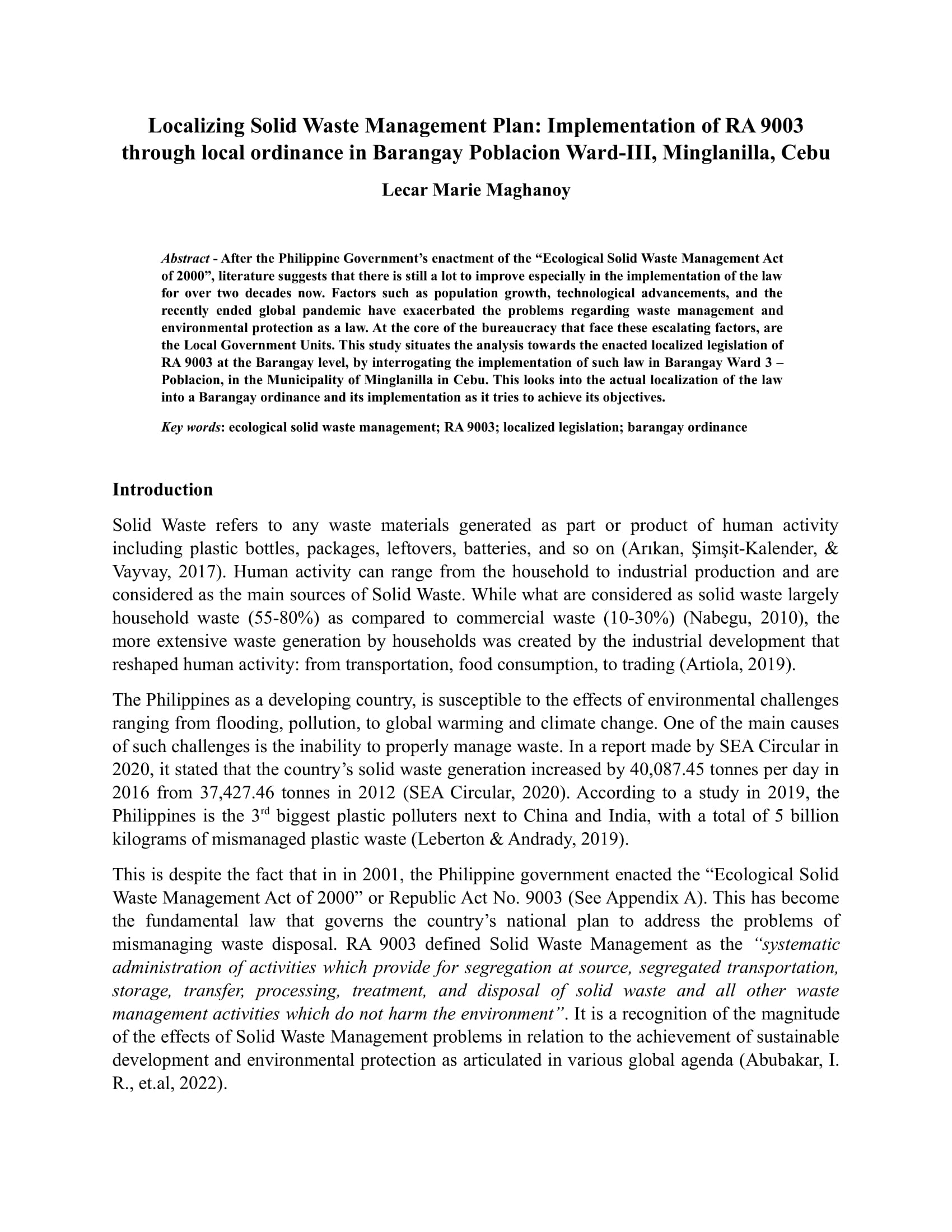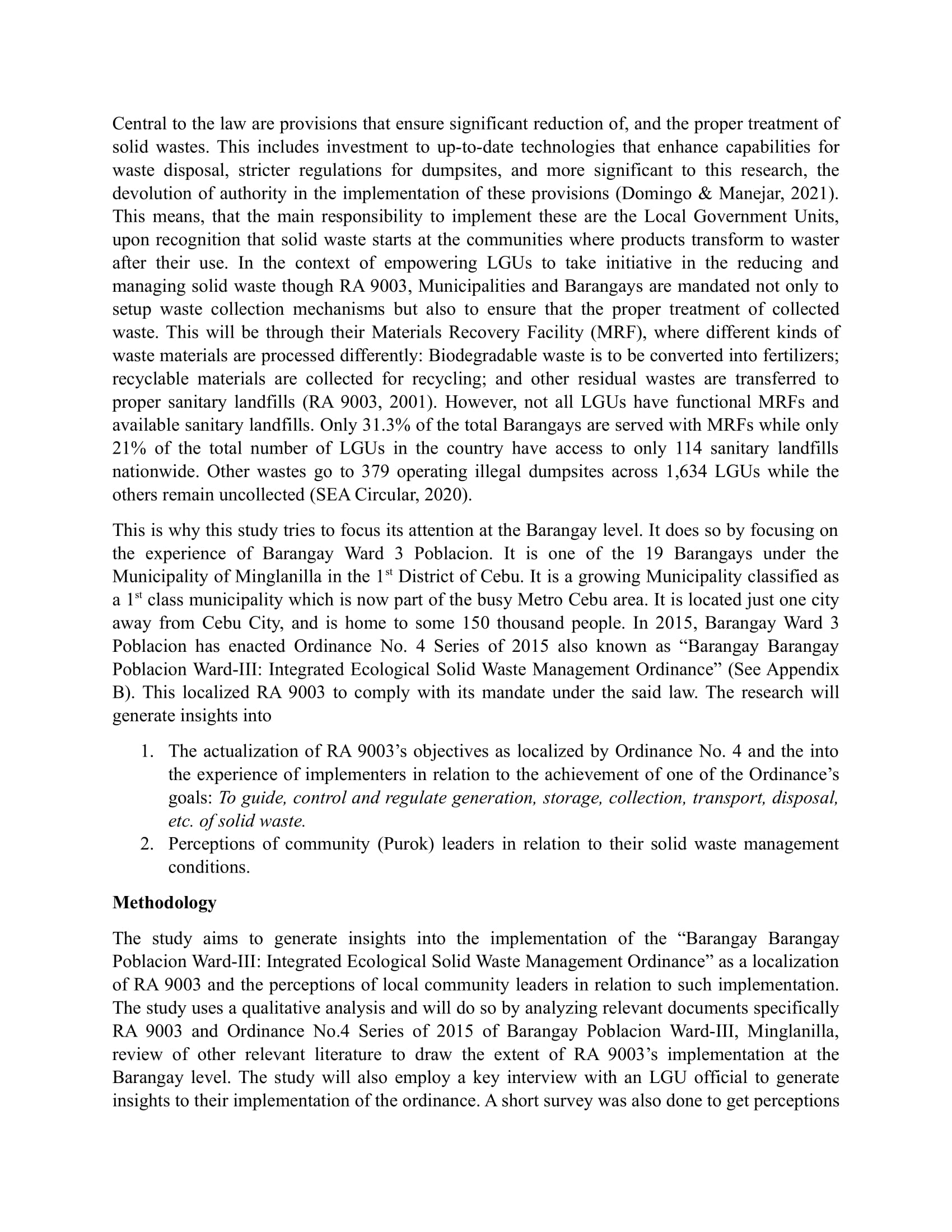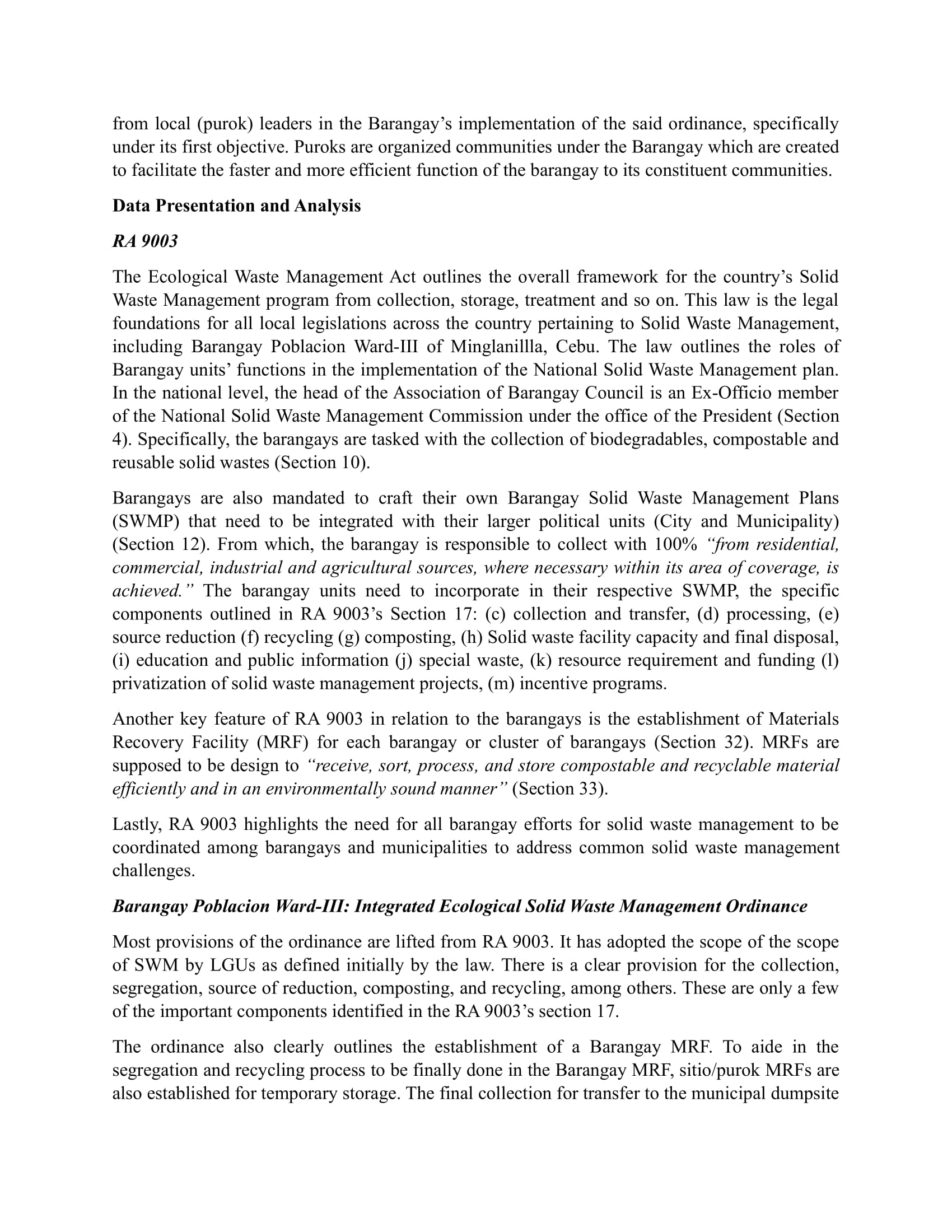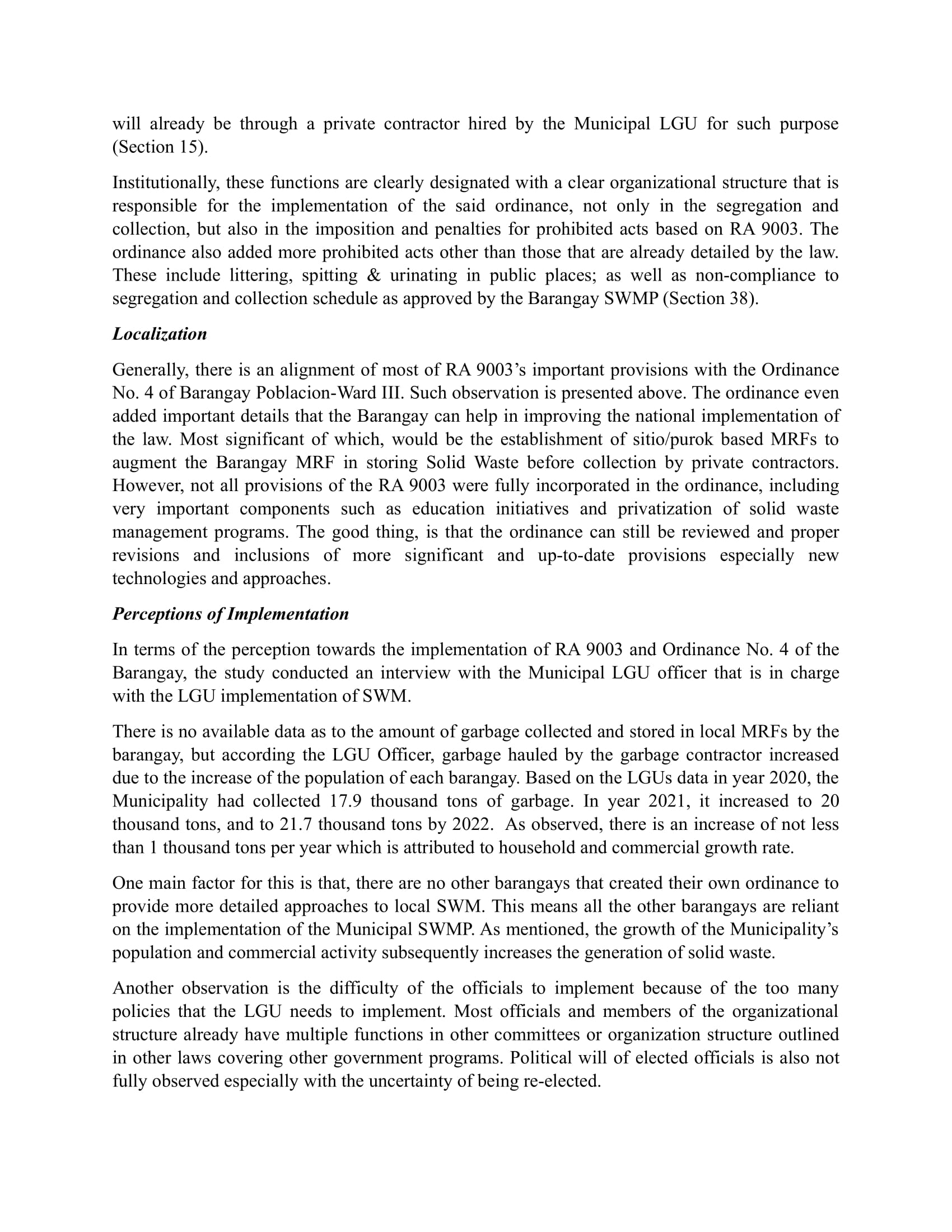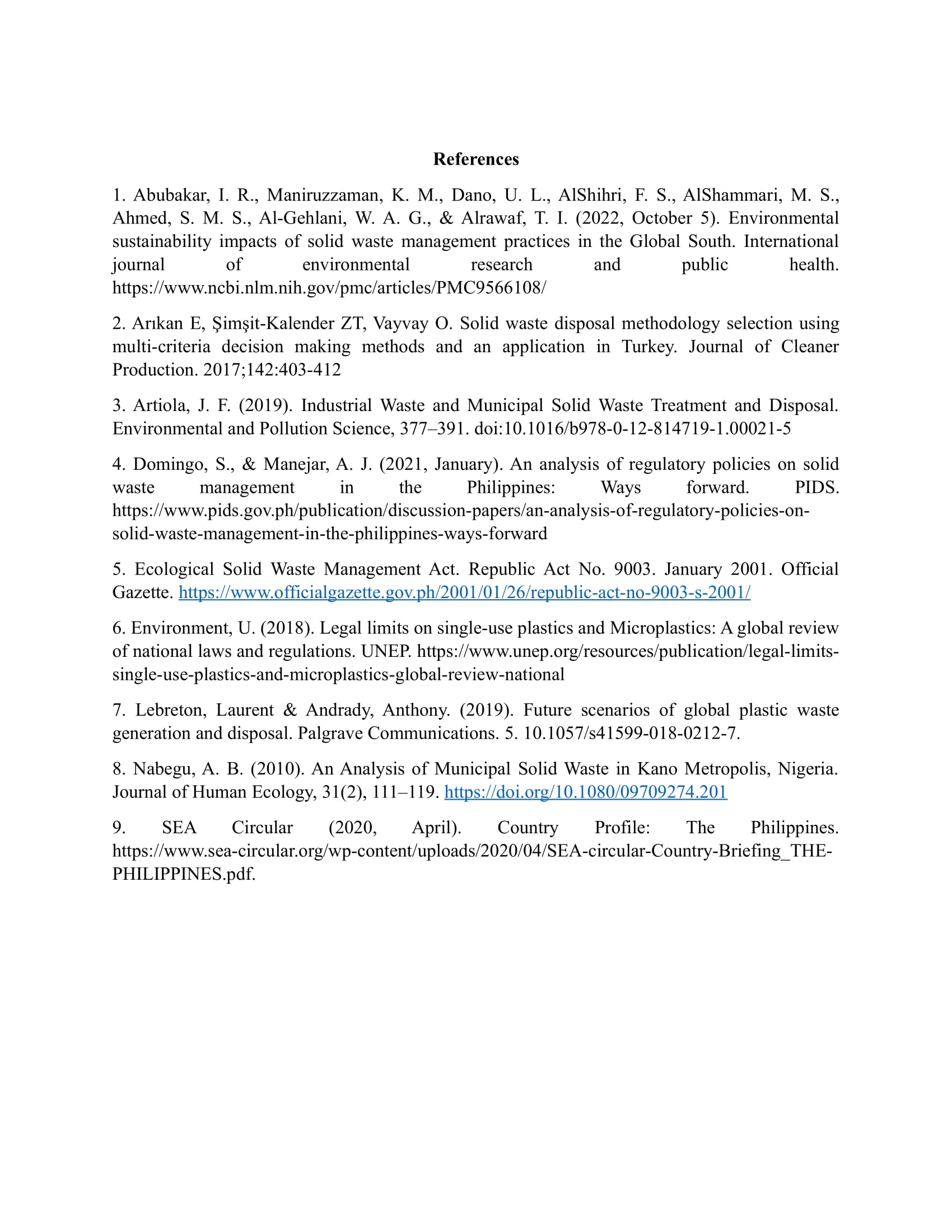Abstract – After the Philippine Government’s enactment of the “Ecological Solid Waste Management Act of 2000”, literature suggests that there is still a lot to improve especially in the implementation of the law for over two decades now. Factors such as population growth, technological advancements, and the recently ended global pandemic have exacerbated the problems regarding waste management and environmental protection as a law. At the core of the bureaucracy that face these escalating factors, are the Local Government Units. This study situates the analysis towards the enacted localized legislation of RA 9003 at the Barangay level, by interrogating the implementation of such law in Barangay Ward 3 – Poblacion, in the Municipality of Minglanilla in Cebu. This looks into the actual localization of the law into a Barangay ordinance and its implementation as it tries to achieve its objectives.
Key words: ecological solid waste management; RA 9003; localized legislation; barangay ordinance
Introduction
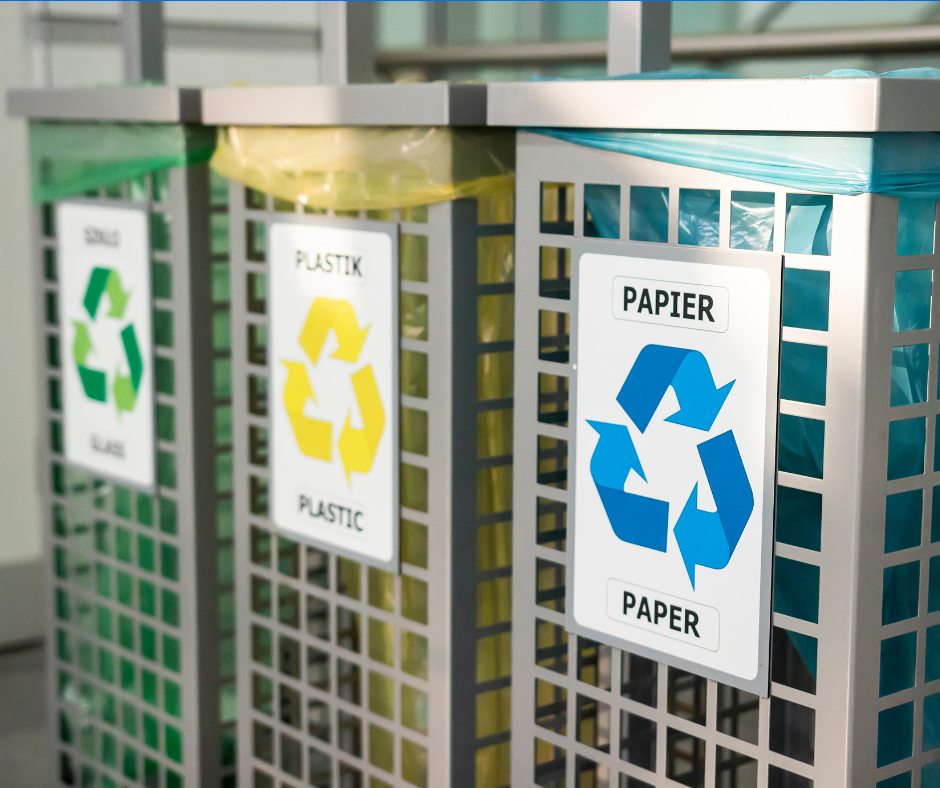
Solid Waste refers to any waste materials generated as part or product of human activity including plastic bottles, packages, leftovers, batteries, and so on (Arıkan, Şimşit-Kalender, & Vayvay, 2017). Human activity can range from the household to industrial production and are considered as the main sources of Solid Waste. While what are considered as solid waste largely household waste (55-80%) as compared to commercial waste (10-30%) (Nabegu, 2010), the more extensive waste generation by households was created by the industrial development that reshaped human activity: from transportation, food consumption, to trading (Artiola, 2019).
The Philippines as a developing country, is susceptible to the effects of environmental challenges ranging from flooding, pollution, to global warming and climate change. One of the main causes of such challenges is the inability to properly manage waste. In a report made by SEA Circular in 2020, it stated that the country’s solid waste generation increased by 40,087.45 tonnes per day in 2016 from 37,427.46 tonnes in 2012 (SEA Circular, 2020). According to a study in 2019, the Philippines is the 3rd biggest plastic polluters next to China and India, with a total of 5 billion kilograms of mismanaged plastic waste (Leberton & Andrady, 2019).
This is despite the fact that in in 2001, the Philippine government enacted the “Ecological Solid Waste Management Act of 2000” or Republic Act No. 9003 (See Appendix A). This has become the fundamental law that governs the country’s national plan to address the problems of mismanaging waste disposal. RA 9003 defined Solid Waste Management as the “systematic administration of activities which provide for segregation at source, segregated transportation, storage, transfer, processing, treatment, and disposal of solid waste and all other waste management activities which do not harm the environment”. It is a recognition of the magnitude of the effects of Solid Waste Management problems in relation to the achievement of sustainable development and environmental protection as articulated in various global agenda (Abubakar, I. R., et.al, 2022).
Central to the law are provisions that ensure significant reduction of, and the proper treatment of solid wastes. This includes investment to up-to-date technologies that enhance capabilities for waste disposal, stricter regulations for dumpsites, and more significant to this research, the devolution of authority in the implementation of these provisions (Domingo & Manejar, 2021). This means, that the main responsibility to implement these are the Local Government Units, upon recognition that solid waste starts at the communities where products transform to waster after their use. In the context of empowering LGUs to take initiative in the reducing and managing solid waste though RA 9003, Municipalities and Barangays are mandated not only to setup waste collection mechanisms but also to ensure that the proper treatment of collected waste. This will be through their Materials Recovery Facility (MRF), where different kinds of waste materials are processed differently: Biodegradable waste is to be converted into fertilizers; recyclable materials are collected for recycling; and other residual wastes are transferred to proper sanitary landfills (RA 9003, 2001). However, not all LGUs have functional MRFs and available sanitary landfills. Only 31.3% of the total Barangays are served with MRFs while only 21% of the total number of LGUs in the country have access to only 114 sanitary landfills nationwide. Other wastes go to 379 operating illegal dumpsites across 1,634 LGUs while the others remain uncollected (SEA Circular, 2020).
This is why this study tries to focus its attention at the Barangay level. It does so by focusing on the experience of Barangay Ward 3 Poblacion. It is one of the 19 Barangays under the Municipality of Minglanilla in the 1st District of Cebu. It is a growing Municipality classified as a 1st class municipality which is now part of the busy Metro Cebu area. It is located just one city away from Cebu City, and is home to some 150 thousand people. In 2015, Barangay Ward 3 Poblacion has enacted Ordinance No. 4 Series of 2015 also known as “Barangay Barangay Poblacion Ward-III: Integrated Ecological Solid Waste Management Ordinance” (See Appendix B). This localized RA 9003 to comply with its mandate under the said law. The research will generate insights into
- The actualization of RA 9003’s objectives as localized by Ordinance No. 4 and the into the experience of implementers in relation to the achievement of one of the Ordinance’s goals: To guide, control and regulate generation, storage, collection, transport, disposal, etc. of solid waste.
- Perceptions of community (Purok) leaders in relation to their solid waste management conditions.
Methodology
The study aims to generate insights into the implementation of the “Barangay Poblacion Ward-III: Integrated Ecological Solid Waste Management Ordinance” as a localization of RA 9003 and the perceptions of local community leaders in relation to such implementation. The study uses a qualitative analysis and will do so by analyzing relevant documents specifically RA 9003 and Ordinance No.4 Series of 2015 of Barangay Poblacion Ward-III, Minglanilla, review of other relevant literature to draw the extent of RA 9003’s implementation at the Barangay level. The study will also employ a key interview with an LGU official to generate insights to their implementation of the ordinance. A short survey was also done to get perceptions from local (purok) leaders in the Barangay’s implementation of the said ordinance, specifically under its first objective. Puroks are organized communities under the Barangay which are created to facilitate the faster and more efficient function of the barangay to its constituent communities.
Data Presentation and Analysis
RA 9003
The Ecological Waste Management Act outlines the overall framework for the country’s Solid Waste Management program from collection, storage, treatment and so on. This law is the legal foundations for all local legislations across the country pertaining to Solid Waste Management, including Barangay Poblacion Ward-III of Minglanillla, Cebu. The law outlines the roles of Barangay units’ functions in the implementation of the National Solid Waste Management plan. In the national level, the head of the Association of Barangay Council is an Ex-Officio member of the National Solid Waste Management Commission under the office of the President (Section 4). Specifically, the barangays are tasked with the collection of biodegradables, compostable and reusable solid wastes (Section 10).
Barangays are also mandated to craft their own Barangay Solid Waste Management Plans (SWMP) that need to be integrated with their larger political units (City and Municipality) (Section 12). From which, the barangay is responsible to collect with 100% “from residential, commercial, industrial and agricultural sources, where necessary within its area of coverage, is achieved.” The barangay units need to incorporate in their respective SWMP, the specific components outlined in RA 9003’s Section 17: (c) collection and transfer, (d) processing, (e) source reduction (f) recycling (g) composting, (h) Solid waste facility capacity and final disposal, (i) education and public information (j) special waste, (k) resource requirement and funding (l) privatization of solid waste management projects, (m) incentive programs.
Another key feature of RA 9003 in relation to the barangays is the establishment of Materials Recovery Facility (MRF) for each barangay or cluster of barangays (Section 32). MRFs are supposed to be design to “receive, sort, process, and store compostable and recyclable material efficiently and in an environmentally sound manner” (Section 33).
Lastly, RA 9003 highlights the need for all barangay efforts for solid waste management to be coordinated among barangays and municipalities to address common solid waste management challenges.
Barangay Poblacion Ward-III: Integrated Ecological Solid Waste Management Ordinance
Most provisions of the ordinance are lifted from RA 9003. It has adopted the scope of the scope of SWM by LGUs as defined initially by the law. There is a clear provision for the collection, segregation, source of reduction, composting, and recycling, among others. These are only a few of the important components identified in the RA 9003’s section 17.
The ordinance also clearly outlines the establishment of a Barangay MRF. To aide in the segregation and recycling process to be finally done in the Barangay MRF, sitio/purok MRFs are also established for temporary storage. The final collection for transfer to the municipal dumpsite will already be through a private contractor hired by the Municipal LGU for such purpose (Section 15).
Institutionally, these functions are clearly designated with a clear organizational structure that is responsible for the implementation of the said ordinance, not only in the segregation and collection, but also in the imposition and penalties for prohibited acts based on RA 9003. The ordinance also added more prohibited acts other than those that are already detailed by the law. These include littering, spitting & urinating in public places; as well as non-compliance to segregation and collection schedule as approved by the Barangay SWMP (Section 38).
Localization
Generally, there is an alignment of most of RA 9003’s important provisions with the Ordinance No. 4 of Barangay Poblacion-Ward III. Such observation is presented above. The ordinance even added important details that the Barangay can help in improving the national implementation of the law. Most significant of which, would be the establishment of sitio/purok based MRFs to augment the Barangay MRF in storing Solid Waste before collection by private contractors. However, not all provisions of the RA 9003 were fully incorporated in the ordinance, including very important components such as education initiatives and privatization of solid waste management programs. The good thing, is that the ordinance can still be reviewed and proper revisions and inclusions of more significant and up-to-date provisions especially new technologies and approaches.
Perceptions of Implementation
In terms of the perception towards the implementation of RA 9003 and Ordinance No. 4 of the Barangay, the study conducted an interview with the Municipal LGU officer that is in charge with the LGU implementation of SWM.
There is no available data as to the amount of garbage collected and stored in local MRFs by the barangay, but according the LGU Officer, garbage hauled by the garbage contractor increased due to the increase of the population of each barangay. Based on the LGUs data in year 2020, the Municipality had collected 17.9 thousand tons of garbage. In year 2021, it increased to 20 thousand tons, and to 21.7 thousand tons by 2022. As observed, there is an increase of not less than 1 thousand tons per year which is attributed to household and commercial growth rate.
One main factor for this is that, there are no other barangays that created their own ordinance to provide more detailed approaches to local SWM. This means all the other barangays are reliant on the implementation of the Municipal SWMP. As mentioned, the growth of the Municipality’s population and commercial activity subsequently increases the generation of solid waste.
Another observation is the difficulty of the officials to implement because of the too many policies that the LGU needs to implement. Most officials and members of the organizational structure already have multiple functions in other committees or organization structure outlined in other laws covering other government programs. Political will of elected officials is also not fully observed especially with the uncertainty of being re-elected.
Perceptions of community leaders
To get into the perception of the community with regards the implementation of the Ordinance and RA 9003, the study did a short survey among purok/sitio leaders with a few descriptive questions about from the visibility of garbage, availability of solid waste facilities, awareness of the law, to the need for government to address the issue of solid waste management.
74% of the respondents sees the proliferation of garbage in their communities while only 26% said that there is not many garbage seen in their community. This somehow reflects the increase of solid waste generation as a result of the increase in household population and commercial activity previously discussed. This may also be caused by the lack of facilities and mechanisms for collection.
The same percentage (74%) said that there is no segregation of garbage in their communities while the others (26%) said there is segregation. Even with the presence of sitio MRFs, segregation is still problematic in the barangay. Household segregation is the start of effective segregation instead of simply relying on MRFs. This could mean that the need to do segregation has not yet been fully popularized despite the presence of a national legislation and a local ordinance. Even if communities are already aware of these national and local legislations. 100% of the total respondents said they know that there is a national law and a local ordinance pertaining to solid waste management. This does not automatically translate to it being the case for all the members of the community. All of them also felt the need for the LGUs to exert more effort in addressing this problem. This re-echoes the observation that not all the important components of RA 9003 are fully incorporated in the Barangay ordinance. Specifically, the role of education and mechanisms for community participation are not outlined in Ordinance No. 4. This explains the high awareness of the law but low translation in garbage collection and segregation.
Conclusions
There is a gap in the law (both RA 9003 & Ordinance No. 4) in terms of coverage and implementation. Upon review, RA 9003 is concentrated on the management of waste as waste already. It is generally reactive than preventive. It does not include specific provisions that regulate sources of solid waste, mainly industries that produce these products that will eventually become waste. While majority of what is considered waste comes from household consumption, it is only made available by the industry and commercial activity that leads to the household. There is no national legislation that goes hand in hand with RA 9003 that regulates plastic generation and pollution (UNEP, 2018).
While there is a general alignment of the intentions by Ordinance No. 4 from RA 9003, the challenges of implementation are still very present in the barangay level. Identified factors are the non-inclusion of important provisions from RA 9003, lack of political will, among others.
Ultimately, these gaps highlight the inability of existing legislations (local and national) to adjust to the exponential increase in waste generation that comes along with population growth and commercial activity growth.
References
- Abubakar, I. R., Maniruzzaman, K. M., Dano, U. L., AlShihri, F. S., AlShammari, M. S., Ahmed, S. M. S., Al-Gehlani, W. A. G., & Alrawaf, T. I. (2022, October 5). Environmental sustainability impacts of solid waste management practices in the Global South. International journal of environmental research and public health. https://www.ncbi.nlm.nih.gov/pmc/articles/PMC9566108/
- Arıkan E, Şimşit-Kalender ZT, Vayvay O. Solid waste disposal methodology selection using multi-criteria decision making methods and an application in Turkey. Journal of Cleaner Production. 2017;142:403-412
- Artiola, J. F. (2019). Industrial Waste and Municipal Solid Waste Treatment and Disposal. Environmental and Pollution Science, 377–391. doi:10.1016/b978-0-12-814719-1.00021-5
- Domingo, S., & Manejar, A. J. (2021, January). An analysis of regulatory policies on solid waste management in the Philippines: Ways forward. PIDS. https://www.pids.gov.ph/publication/discussion-papers/an-analysis-of-regulatory-policies-on-solid-waste-management-in-the-philippines-ways-forward
- Ecological Solid Waste Management Act. Republic Act No. 9003. January 2001. Official Gazette. https://www.officialgazette.gov.ph/2001/01/26/republic-act-no-9003-s-2001/
- Environment, U. (2018). Legal limits on single-use plastics and Microplastics: A global review of national laws and regulations. UNEP. https://www.unep.org/resources/publication/legal-limits-single-use-plastics-and-microplastics-global-review-national
- Lebreton, Laurent & Andrady, Anthony. (2019). Future scenarios of global plastic waste generation and disposal. Palgrave Communications. 5. 10.1057/s41599-018-0212-7.
- Nabegu, A. B. (2010). An Analysis of Municipal Solid Waste in Kano Metropolis, Nigeria. Journal of Human Ecology, 31(2), 111–119. https://doi.org/10.1080/09709274.201
- SEA Circular (2020, April). Country Profile: The Philippines. https://www.sea-circular.org/wp-content/uploads/2020/04/SEA-circular-Country-Briefing_THE-PHILIPPINES.pdf.
This paid content is brought to you by Lecar Marie Maghanoy.
ADVERTORIAL
RELATED STORIES:
No Time To Waste: A collaboration
